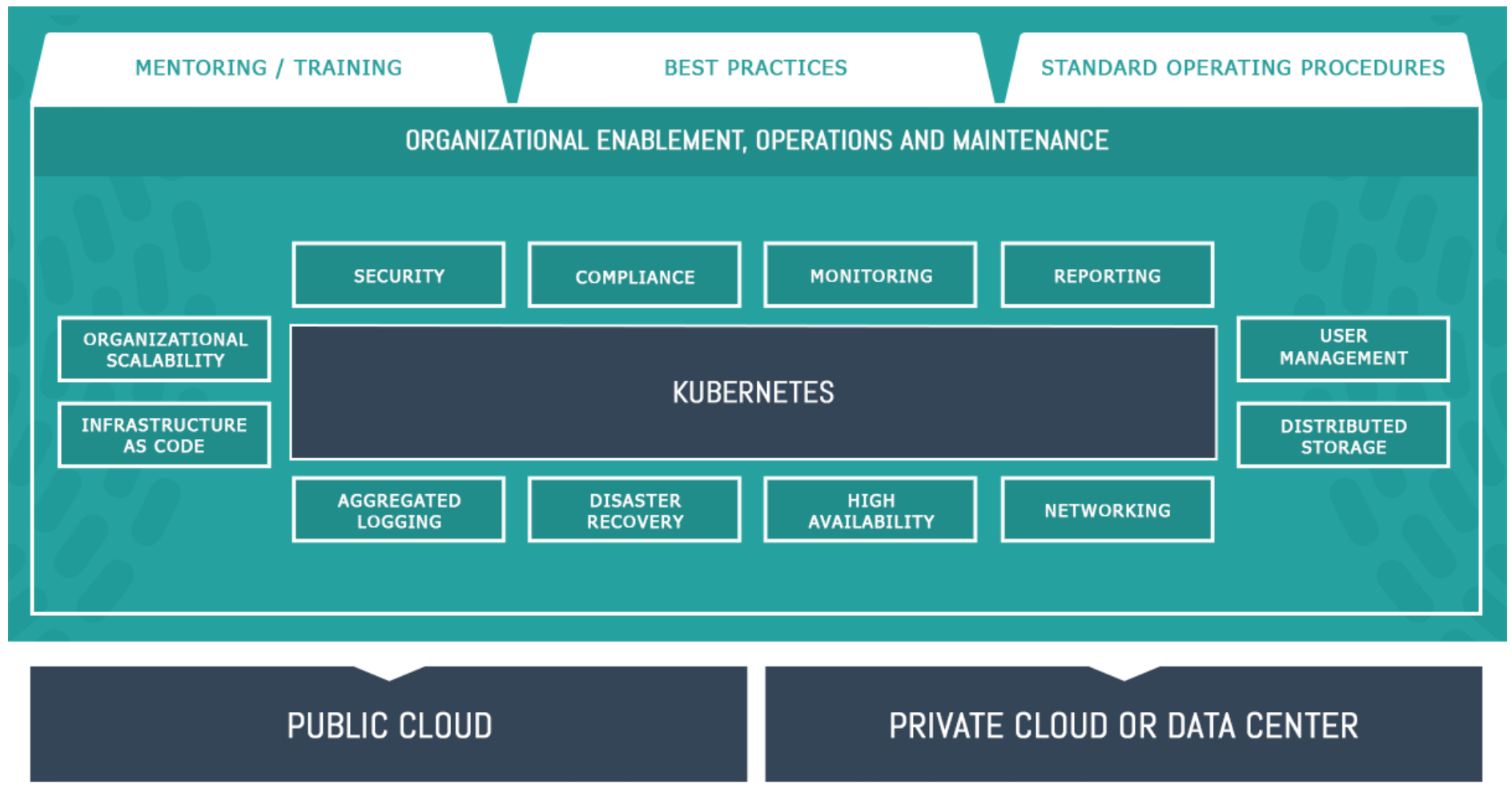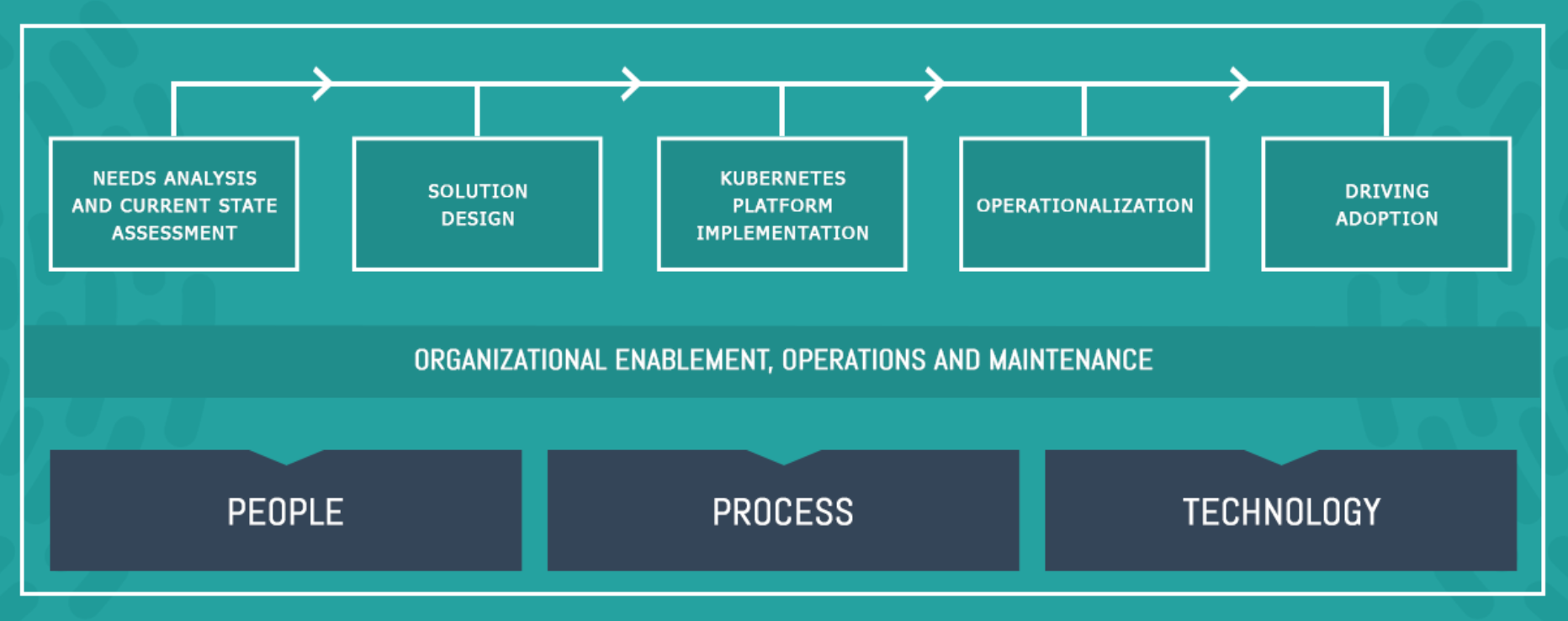What to Know About Accelerating Kubernetes and Cloud-Native Transformation
The Challenge
Cloud-native architectures and applications deliver a competitive edge for any business. Companies have realized that transformation offers the potential of accelerated end-user experiences while simultaneously keeping overhead costs to a minimum. Transition to cloud-native is no small task, however. To achieve this transition, companies must overhaul their systems and approaches. A key part of this overhaul includes the use of enterprise-ready container orchestration platforms like Kubernetes.
The Kubernetes container orchestration platform helps speed the adoption of cloud-native solutions. The system leverages containers to provide a platform for cloud testing and implementation. However, operationalizing the Kubernetes platform for an enterprise requires extensive installation, configuration and design. Considerations beyond basic installation and configuration of Kubernetes include, but are not limited to:
- Security
- Compliance
- Monitoring
- Reporting
- Governance
- Aggregated logging
- Dynamic networking
- Organizational scalability
- Backup and recovery
- Training existing teams
- Driving enablement and adoption
Many IT organizations and teams have attempted to adopt Kubernetes and cloud-native technologies with varying levels of success. Some attempts take significantly longer than expected, with projects lasting over six months. Other attempts have incurred higher investments due to larger team sizes. The vast majority of these attempts rarely end up with a system designed around industry best practices.
At Oteemo, we have amassed years of experience in building, deploying and managing enterprise-scale Kubernetes for various enterprises to help our clients achieve the accelerated delivery and cost savings that they need. With our extensive experience we’ve learned from real-world implementations and created a comprehensive, repeatable Kubernetes adoption framework. We call this framework and approach “XC”, short for “Xcellerated Containers.”
The Oteemo Advantage
The Oteemo XC approach allows clients to accelerate the adoption of Kubernetes enterprise-ready Kubernetes by deploying key capabilities. This approach for accelerating our client’s journey to containers includes a blend of people, process and technology to ensure that teams are not only up-and-running as fast as possible but also become self-sufficient.
Our approach to enterprise containers and cloud-native solution starts with the widely-adopted Kubernetes platform. After the installation of the Kubernetes platform, other tools that address common enterprise concerns such as security, compliance, deployment automation, monitoring, reporting, governance, aggregated logging, secure networking, scalability, backup and recovery, etc. are installed and configured. The technologies and tools that we picked to deliver these enterprise capabilities for container solutions within Kubernetes are a combination of open source and proprietary products. We provide a comprehensive list of the pros and cons of various options of such tools for our clients and work with our clients during the design phase to pick the right tool set that fits their organizations.
Following are few enterprise capabilities that are accelerated through our approach to deploying enterprise-ready Kubernetes:
Security: Oteemo XC implements security at every level to provide in-depth defense. We install host, network, cloud-provider and Kubernetes-level security for a whole-application approach. Some security options even include technologies that ensure build-time and run-time governance for secure containers. The security our team implements within this platform is the result of our expertise across a variety of client implementations with varying security needs.
Infrastructure-As-Code: The XC framework saves all infrastructure changes to the Kubernetes cluster as a versionable code. Whether the change is an application deployment or a security configuration, we save each new version in a version control repository. This system of making updates to the cluster through code facilitates workflows, auditability and cluster parity. In this way, we can ensure that the cluster state matches the version control and that the history of your cluster is visible and traceable.
Cloud and Infrastructure Agnostic: Kubernetes is cloud and infrastructure agnostic, meaning that it can run anywhere. Kubernetes achieves this by abstracting cloud resources, allowing your application deployments and configurations to remain the same no matter where they are running. This means that Kubernetes can run on the cloud, in private data centers and on bare metal. The result is that your teams can learn one platform and run it anywhere with confidence. The process of achieving this multi-cloud architecture can be accelerated using the XC framework’s automation scripts and capabilities.
Aggregated Logging: Log management is often a complicated process. Usually, this process involves figuring out how to get logs from an application to the logging solution via plugins and other methods. The XC approach simplifies this process. Our framework uses Kubernetes’ native logging capabilities to send host and container logs to your logging solution of choice. This system allows your container logs to become instantly searchable, allowing your team to see how applications are performing and troubleshoot issues as they arise. Developers, security engineers and operations team members will all have access to the logs necessary to do their jobs without requiring host or container access to read application output.
Monitoring/Metrics/Alerting: The XC framework comes with a built-in monitoring, metrics and alerting system based on the industry-recognized Prometheus metrics collection engine. With this system, metrics are gathered at every layer — host, Kubernetes and application. The metrics are then aggregated into a single platform and visualized using Grafana. Your team can further customize the system to set up alerts in response to specific metrics, letting teams know when something in the platform needs attention. This system can even grow with your platform’s needs. This proactive monitoring is meant to ensure that your teams have the operational insight needed to provide a stable platform and troubleshoot quickly in the event of a problem.
High Availability and Disaster Recovery: We design our Kubernetes deployment approach to reduce risk for our customers. A key part of this involves providing high availability for their applications across data centers. Kubernetes masters are run in quorum and clusters are run with even distribution across data centers. This means that the data plane and all applications are always available. For your business, this means that outages and disasters are less likely to impact your day-to-day operations, eliminating the need for costly disaster recovery solutions. XC automation adds further operability to this system. XC systems can quickly span multiple regions or cloud providers to meet your company’s disaster recovery needs by running your applications in “hot-hot” or “hot-warm” architectures. This allows applications in live deployments to transition over to another system rather than fail.
User Management: User management is made simple with XC’s configurations. Typically, an organization manages users through a single sign-on tool of choice. This tool allows managers to allocate resources to specific groups and individuals. This sign-on tool is then integrated into Kubernetes role-based-access-control. XC further improves this system by including the option of having individual user additions. This method of role management allows small changes to be made to individual access controls without changing other roles or adding new roles into the system. This method of managing users also facilitates approval workflows and auditable control of access to the cluster.
Distributed Storage: Cloud provider storage systems, like elastic block storage (EBS), often only partially fulfill application needs. This is because systems like EBS systems are usually bound to individual data-centers. This limits the ability of applications to move in the event of a failure. The XC framework provides a solution through networked storage models. Our networked solution for Kubernetes uses technologies such as Ceph and GlusterFS, which can span data centers. This capability provides additional resiliency for applications with persistent storage needs.
Technical and Organizational Scalability: Modern workloads are unpredictable and change frequently. As a result, modern businesses need solutions that are elastic enough to scale with their needs. Through XC, Kubernetes can scale at both the machine and application levels based on the business’ needs. The solution scales seamlessly as the organization grows, supporting the addition of workers to the compute pool and the creation of additional Kubernetes namespaces with specific resource allocation including network, CPU and memory. New teams can be given a secure enclave in which to create and deploy their containerized applications, which helps introduce them to the platform in a controlled manner. In total, this scaling capability helps businesses keep costs down while maintaining the flexibility to be ready when more horsepower is needed.
Cost Savings of Digital Transformation
Innovation of any type requires investment, which can be a point of concern for any business. However, innovation through digital transformation, when done methodically, has been shown to offer significant cost savings that offset the costs of investment. In fact, a report from the Cloud Industry Forum found that cost savings were a primary driver for digital transformation for 72% of surveyed IT professionals and 68% of surveyed business professionals in 2018.
Cloud-native application development offers significant cost savings primarily through the following means:
- Simplified management: Cloud-native applications are designed for easy management and maintenance. Automated logging and alerting are made easy with cloud-based systems and integration is easier than ever, resulting in improved functionality and productivity overall.
- Reduced downtime: Cloud-native apps are more reliable than on-site systems, reducing downtime due to outages and disasters. The result is lower repair expenses and improved productivity for your business, driving profits and cutting costs.
- Maximum scalability: Cloud infrastructures are highly scalable, and cloud-native applications offer the same benefits. Cloud-native apps have the ability to evolve and grow with your systems and business requirements, meeting your needs without incurring significant upgrade costs.
- Improved automation: Digital transformation can improve the capacity of applications to work in an automated manner, minimizing manual processes and reducing labor costs. Instead of dedicating personnel to easily automated processes, your trained staff can be relocated to more profit-building areas of the business without sacrificing operability.
- Increased satisfaction: Higher productivity and reduced downtime mean improved satisfaction for employees and customers alike, driving growth and profitability for your business.
These benefits result in the increased accessibility and space offered by a cloud environment, as well as in massive improvements in cost savings and profit generation. It’s essential to remember, however, that these cost-saving opportunities are only achieved through true digital transformation. The mistake that many companies make is to take their existing applications and move them to the cloud as they are. These applications aren’t built to take advantage of the unique capabilities of cloud computing, making them less effective and incapable of achieving the automation and scaling required to achieve maximum cost efficiency. Only through digital transformation can businesses fully realize the cost-savings of the cloud. Oteemo can help your business achieve it faster.
How Oteemo Can Accelerate Cloud-Native Transformation and Kubernetes Adoption
Oteemo focuses on accelerating cloud-native transformation and Kubernetes adoption in a way that best suits the needs of your business. Our approach begins by learning everything there is to know about your business and your technical drivers for container technologies. From there, we go through a series of two-week sprints to create, implement, operationalize and migrate, resulting in your business’ complete transformation. The process works like this:
1. Assessment and Planning
Oteemo begins every engagement by first understanding our client’s company, including the business and technical drivers for container technologies. From there, we map out the client’s needs and drivers, outlining realistic goals and timelines to ensure that all teams are on the same page.
Once a general plan is in place, Oteemo quickly assesses the current state of the client’s existing engineering practices and processes, including:
- Development
- Testing
- Security
- Deployment
- Configuration management
- Operations
Once we’ve completed the assessment, we use the compiled information and the outline to create a comprehensive implementation plan.
2. XC Kubernetes Implementation and Operationalization
Once a plan is in place, the team moves into the Kubernetes implementation stage using our proven XC framework approach. XC is the approach that we take to our clients to accelerate the adoption of Kubernetes. This approach, based on years of experience in real-world implementations, involves a blend of people, process and technology. The result, however, is the same — rapid design, implementation, roll-out and adoption of enterprise-grade Kubernetes and cloud-native architectures.
Our approach starts with the widely-adopted Kubernetes platform. Our team goes through a couple of two-week sprints to implement and configure the Kubernetes platform. This process includes installing and configuring other tools that address common enterprise concerns. These concerns include security, compliance, monitoring, reporting and other key aspects. We use a combination of open source and proprietary technologies to deliver these capabilities.
Once implementation is complete, the team then shifts focus to operationalizing the platform to meet the organization’s needs. This includes implementing any custom integrations and requirements that the company needs.
Of course, our clients are involved in every step of the process. For every tool that we use, we provide a comprehensive list of pros and cons. We then work with our clients during the design phase of the framework to pick the right set of tools for their needs. We may also discuss potential changes to existing organizational processes to help drive efficiency.
It is in this process of implementation and operationalization where we deliver the promise of acceleration to our clients. Where many organizations with limited experience with containers and cloud-native solutions can take six months to design, implement and operationalize a baseline Kubernetes platform, the XC framework completes implementation and operationalization in three sprints, totaling six weeks of work. From six months to six weeks is a huge amount of time and cost savings for our clients.
3. Migration and Adoption
As soon as the Kubernetes platform is completely operational, we move on to the last phase, which involves migrating applications and adopting the platform entirely. Oteemo works with our clients’ application and operations teams to create deployment models to seamlessly promote applications and services into Kubernetes. We help create dashboards for proactive monitoring and business analytics. We also develop a plan to enable the operations teams to operate and maintain the platform and work with our customer’s engineering teams to drive the adoption of the platform across the organization.
Let’s Accelerate
At Oteemo, our goal is to help drive innovation and reduce the time to market for our customers. With a focus on mentoring, enablement and adoption of Kubernetes in our customer’s organizations, we will ensure that the right cloud-native and enterprise container solution is designed and implemented in a fast and efficient manner. Leverage Oteemo’s wealth of expertise and drive your digital transformation goals and stay ahead of your competition. Contact Oteemo today.











0 Comments